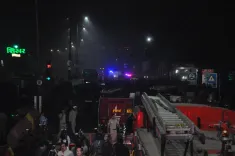Why Has a Three-Day Mourning Period Been Declared in Russia's Far East after a Plane Crash?

Synopsis
Key Takeaways
- Three-day mourning period declared in response to the tragic plane crash.
- All individuals aboard the An-24 aircraft were confirmed deceased.
- Financial compensation for victims' families will be provided.
- A governmental commission is formed to manage the investigation.
- Initial reports indicate no distress signals were sent prior to the crash.
Vladivostok, July 25 (NationPress) Authorities in Russia's Amur Oblast and Khabarovsk Territory have initiated a three-day mourning period concluding on Sunday following the tragic crash of an An-24 passenger aircraft, which resulted in the loss of all individuals aboard.
Governor Vasily Orlov shared on his Telegram channel, "With profound grief, I announce that there are no survivors from the An-24 plane crash in Tynda, based on preliminary reports. A mourning period has been established in the Amur Oblast, with flags to be flown at half-mast throughout the region on July 25, 26, and 27."
The Khabarovsk regional government has also declared a mourning period as several victims were from that area.
Governor Dmitry Demeshin stated that each bereaved family will receive 1 million rubles (approximately $12,500) in compensation, as well as assistance with travel expenses to the crash site, according to the Xinhua news agency.
Transport Minister Andrey Nikitin confirmed that all necessary funds would be distributed to the families of the deceased passengers and crew members.
On Thursday, Russian President Vladimir Putin conveyed his condolences.
The aircraft, managed by Angara Airlines, lost radar contact on Thursday morning while nearing Tynda airport. Its wreckage was subsequently located on a mountainside about 15 km from the city.
Prime Minister Mikhail Mishustin has mandated the formation of a governmental commission, led by Nikitin, to manage the response and compensation efforts. A criminal investigation has been initiated to examine the circumstances surrounding the crash.
The Transport Ministry reported that the aircraft was carrying 42 passengers and six crew members, which included five children.
Remarkably, the aircraft did not issue any distress signals prior to its disappearance, raising significant concerns regarding the incident.
Initial findings suggest that the An-24 might have been attempting a second landing approach at Tynda Airport when it lost radar contact.









